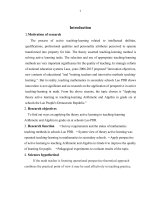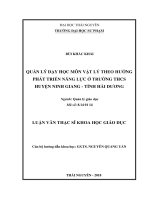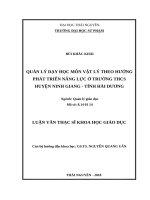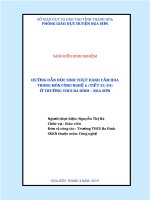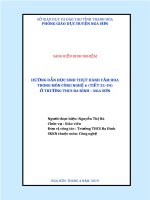Tóm tắt tiếng anh: Dạy học môn Công nghệ dựa vào năng lực ở trường Trung học cơ sở.
Bạn đang xem bản rút gọn của tài liệu. Xem và tải ngay bản đầy đủ của tài liệu tại đây (143.14 KB, 27 trang )
MINISTRY OF EDUCATION AND TRAINING
HANOI NATIONAL UNIVERSITY OF EDUCATION
BUI MINH HAI
COMPETENCY-BASED TEACHING IN TECHNOLOGY
EDUCATION AT SECONDARY SCHOOL
Major: Theory and Methods of Teaching in
Industrial Engineering Pedagogy
Code: 9.14.01.11
SUMMARY OF EDUCATIONAL SCIENCE DOCTOR’S THESIS
Hanoi - 2022
The work was completed at Hanoi National University of Education
Scientific instructor 1: Assoc.Prof.Dr. Nguyen Van Binh
Scientific instructor 2: Dr. Nguyen Thi Thu Ha
Review 1: Assoc.Prof.Dr. Pham Kim Chung
VNU University of Education - Vietnam National University, Hanoi
Review 2: Assoc.Prof.Dr. Nguyen Hoai Nam
Hanoi National University of Education
Review 3: Assoc.Prof.Dr. Nguyen Phuc Chinh
University of Education - Thai Nguyen University
The thesis will be defended in front of the School-level Thesis
Assessment Committee at the Thesis Defense Room, 2nd floor of
the Library, Hanoi National University of Education 136 Xuan Thuy, Cau Giay, Hanoi
on .... hour ..... day .... month .... year .....
The thesis can be found at the: National Library, Hanoi.
Or the Library of Hanoi National University of Education
1
INTRODUCTION
1. Introduction
1.1. Legal basis
The Resolution No. 29/NQ/TW of the 8th Plenum of the 11th Party
Central Committee clearly defined the guiding viewpoint to strongly
shift the educational system from traditional (knowledge transmission)
to competency-based education; theory associated with practice;
educating people both to meet social requirements and to develop the
highest potential of everyone; focusing on teaching how to learn, how
to think and self-study.
The Official Letter No. 4612/BGDDT-GDTrH dated October 3,
2017
of
the
Ministry
of
Education
and Training
guiding
implementation of the current general education program in
accordance with the orientation of competency-based education from
the school year 2017- 2018, which encourages teachers to base on the
current curriculum to select topics, content design, restructure the
lesson to carry out teaching activities in the competency-based
education appropriately to the actual conditions of the school
1.2. Theoretical basis
Concepts of competency-based education are also continuously
revised to suit educational realities, and most recently is the update of
a new definition of competency-based education in 2019 in general
education. This makes previous studieds on competency-based
teaching in general education, partly outdated, incompatible with the
new concept. Therefore, although competency-based teaching is not a
new topic, new concepts in competency-based education have made
the research of competency-based teaching in the general education
2
become new and urgent in the current context, inheriting and without
overlapping with previous studies.
1.3. Practical basis
The reality of teaching Technology at secondary schools shows that
up to 67.8% of teachers thought that the current knowledge of
Technology is not yet practical; 48.3% of teachers confirmed that
students find it difficult to apply knowledge in practice; 57.8% of
teachers had difficulty in organizing teaching some content in
textbooks in a way that is closely related to reality, so they often
ignore it.
The above problems show that the study on the topic
"competency-based teaching in technology education at secondary
school" becomes urgent, new, inherited and not duplicated with
previous studies.
2. The purpose of research
Systematize a theoretical model of competency-based teaching and
propose a procedure of the design of competency-based teaching in
technology education in the secondary school to help students achieve
technological competencies as required by the 2018 General
Education Program in Technology.
3. Object, subject and scope of research
3.1. Research object
The process of competency-based teaching and learning in
technology education in secondary schools.
3.2. Research subject
A procedure for the design of competency-based teaching in
technology education in secondary schools on the development of
3
students' technological competencies as required by the 2018 General
Education Program in Technology.
3.3. Research scope
- Surveying the status of competency-based teaching in technology
education in secondary schools in Hung Yen province.
- Designing for competency-based teaching in Technology 9
subject (Module: Electrical circuit in the house).
- The experimental method was conducted at Trung Hung
Secondary School, Yen My district, Hung Yen province.
4. Tasks of Research
- Literature review on competency-based teaching in general
education and its applications in teaching technology.
- Analysis of the theoretical basis of competency-based teaching in
technology education in secondary schools.
- Survey on the status of competency-based teaching in technology
education in secondary schools.
- Designing competency-based technology teaching in secondary
schools.
- Pedagogical experiment.
5. Research hypothesis
When Vygotsky's Zone of Nearest Development theory is used to
explain the mechanism of student’s competency development and
systematizes a theoretical model of competency-based teaching,
combined with a design process for competency-based teaching in
technology education in secondary schools clearly, the competencybased teaching in technology education in secondary schools will help
students achieve technological competencies as required by the 2018
General Education Program in Technology.
4
6. Research methods
6.1. Theoretical meta-analysis
Meta-analysis was used to have general review, build a theoretical
basis for competency-based teaching in general education and its
application in teaching Technology in secondary school.
6.2. Questionaire survey
Questionnaire was used to investigate the current situation of
teaching Technology from the viewpoint of competency-based
teaching. A cross-sectional survey was conducted to collect data from
60 Technology teachers and 308 students of technology class in Hung
Yen province.
6.3. Pedagogical experiment
Conduct experiments with illustrated lessons in Technology 9
which are designed with competency-based teaching to exam its
impact on student learning outcomes.
6.4. Mathematical statistics
Statistical test was applied to analyze and synthesize data obtained
through surveys and experiments with SPSS support to draw
appropriate conclusions. The chosen alpha significance level was
95%.
7. New contributions of this study
Systematize basic theoretical model on competency-based teaching
in general education and using this model in technology education at
secondary schools. In which, focus was on further clarifying the
approach to the concept of competency in general education and using
Vygotsky's Zone of Proximal Development to explain the students'
mechanism of accumulation and competency development; using
Vygotsky's scaffolding theory to explain the nature of the competencybased teaching concept. Biggs' model of 'constructive alignment' was
5
used to explain components of competency-based teaching. Since
then, Bloom's theory was used to guide how to describe student
ability, 4C/ID model in cognitive load theory to guide how to design
learning tasks and competency-based teaching.
Provide a cross-sectional survey report on the current situation of
competency-based teaching in technology education at secondary
schools in the second semester of the academic year 2017 - 2018. New
findings from survey results showed that the teaching old Technology
subject is not fully developing technological competency for students
as required by the 2018 General Education Program in Technology.
Teaching Technology subject has not yet fully achieved the
characteristics of competency-based teaching, so it needs continued
improvement. The reality research results also showed the need to
apply new perspectives of competency-based Technology teaching
and apply the 4C/ID model in designing and teaching Technology.
Propose a procedure for the design of competency-based teaching
in technology education in secondary schools; illustrate in the
designing process of 'Lesson 9 - Circuit with two three-pole switches
controlling one light'. The pedagogical experiment result of 'Lesson 9'
has found that competency-based Technology teaching has a positive
impact on students' learning outcome.
6
CHAPTER 1. LITERATURE REVIEW ON COMPETENCYBASED TEACHING IN GENERAL EDUCATION AND ITS
APPLICATIONS IN TEACHING TECHNOLOGY
1.1. Literature review approach
The ERIC and Google Scholar databases were used to search for
international documents, while manual search was used to find
Vietnamese documents, including books, journals, and articles posted
on the website related to competency-based teaching.
Of the 50 English documents found, 45/50 (90%) documents are
less than 10 years old, 35/50 (70%) documents are less than 5 years
old, that is, the overall analysis result is highly up-to-date with new
research. In addition, 50 quality Vietnamese documents were found by
manual search.
The "review of literature" approach was used to review literatures
on four broad themes: (1) an literature of the trend of transition to
competency-based education; (2) concepts of competency-based
education; (3) literature of competency-based teaching; (4) literature
of competency-based teaching in technology education.
1.2. Trends of the transition to competencybased education
The competency-based education movement began more than 100
years ago. Up to now, competency-based education is becoming a new
educational model for educational reform in the 21st century. In
general education, many studies have confirmed that competencybased education can help ensure that high school student graduate
with the knowledge and skills necessary for their college and their
careers. The United Nations and the Organization for Economic Cooperation and Development are leading the discussion on education
7
reform, leading the way in spreading awareness of competency-based
education.
1.3. The conceptual change of competency-based education
1.3.1. Foreign studies
In general education, a definition of competency-based education
was truly agreed upon in 2011 at the National Summit on
Competency-based K-12 Education (held at Aurora Institute, USA).
Eight years after the initial definition was created, feedback from
across the field indicated that it needed updating. At the Second
National Summit on Competency-based K-12 Education in 2017, a
new definition of competency-based education was updated which
emphasized how students were empowered on a daily basis to make
important decisions about their learning experience, how they would
create and apply knowledge, and how they would demonstrate their
learning.
1.3.2. Studies in Vietnam
The Ministry of Education and Training has developed the 2018
National Education Program in the direction of competency
development. Technology education is carried out from grade 3 to
grade 12 to develop students’ technological competency with
components "cognition, communication, use, evaluation of technology
and engineering design". This posed an issue of teaching the current
Technology subject according to the orientation of the 2018 National
Curriculum.
1.4. Literature of competency-based teaching
1.4.1. Foreign studies
The former one-size-fits-all teaching and assessment no longer
equitably meet requirements of all students, competency-based
education has not only emerged as a real transformation for traditional
8
schools aimed at revolutionizing student learning. Competency-based
teaching leads to change in learning by addressing rigorous learning
objectives, competency-based assessment, and evidence-based
grading. Learning becomes personalized by maximizing the time,
place, and pace of learning with a proactive pathway to academic
content and development of personal success skills. Along with that,
students must demonstrate proficiency in all competencies, students
make progresses when they have demonstrated proficiency; assessed
by a variety of measures to determine proficiency.
1.4.2. Studies in Vietnam
Competency-based teaching often focuses on application in
teaching specific subject areas. There have been many doctoral theses
which carried out research on competency-based teaching in
Chemistry, Physics, Mathematics and Technology. However, a
weakness in these studies is that new perspectives on competencybased teaching have not been updated sufficiently
1.5. Literature of competency-based teaching in
technology education
1.5.1. Foreign studies
Over the past decade, there has been a dramatic shift in technical
education towards competency-based teaching. Analysis of the search
results (from 2005 to 2015) on competency-based teaching in
technical education has shown that theoretical and applied
perspectives are given to address both theoretical basis of the
effectiveness of competency-based teaching and practical aspects of
successful competency-based instructional implementation in
engineering education. The authors also pointed out future research
directions that need to focus on empirical quantitative assessments of
9
competency-based teaching and the use of competency-based teaching
in specific technical areas.
1.5.2. Studies in Vietnam
There are many outstanding studies in both theory and practice on
competency-based teaching and assessment in engineering/
technology education. From 2018 to 2020, Le Huy Hoang and his
associates edited 5 books that provided guidance on teaching
Technology to the 2018 General Education Program, oriented to
competency development. However, there has not been a general
study on Competency-based teaching in Technology education.
CONCLUSION OF CHAPTER 1
Competency-based education is becoming a fundamental
educational model for education reform in the 21st century. The
concept of competency-based education is continuously revised and
improved, closer to the reality of education. Competency-based
teaching - an important stage in competency-based education also has
more innovative and progressive concepts. The meta-analysis also
showed a dramatic change of competency-based teaching in
engineering education over the past decade. However, published
studies on competency-based teaching in technology education in high
schools show that teaching often only focuses on developing general
and individual technological competencies. It has not adequately
studied the development of technological capabilities as required by
the 2018 General Education Program in Technology. This poses a
problem in applying new concepts of competency-based teaching in
technology education in the secondary schools, thereby developing the
technological competencies for students as required by the 2018
General Education Program in Technology.
10
CHAPTER 2. THEORETICAL BASIS OF COMPETENCYBASED TEACHING IN TECHNOLOGY EDUCATION AT
SECONDARY SCHOOL
2.1. Basic Concepts
2.1.1. Competency and structure of competency
This thesis defined: " Competency is the learner ability to create
job performance in accordance with actual contexts and situations to
achieve expected results in employment".
This concept can be further explained more clearly in teaching
Technology: "Competency is the learner ability for job performance to
achieve desired results in cognition, use, communication, technology
assessment and engineering design".
The basic components of human ability include: Knowledge, skill
and attitude.
The Zone of Proximal Development developed by the psychologist
Lev Vygotsky (1896-1934) can be used to explain the general and
growing accumulation of competencies.
2.1.2. Technology competencies of K-12 students
The technology competencies of high school students are described
in the 'Technology Program 2018', including awareness,
communication, use, evaluation of technology and engineering design.
2.1.3. Competency-based teaching
Competency-based learning is a learning model in which students
move from one level of learning to another based on the
demonstration of their knowledge rather than on the time spent in a
particular course.
Competency-based teaching is an approach to teaching, assessing,
and grading learning based on students demonstrating that they have
11
progressed in their own abilities based on evidence of their mastery of
knowledge and skills according to the expected output.
Competency-based teaching and learning is a set of designs and
practices for teachers and students that enable students to successfully
experience competency-based learning activities.
2.2. Features of competency-based teaching in general education
2.2.1. New conception of competency-based education
in general education
The revised 2019 definition of competency-based education is
described in seven key elements:
1. Students are empowered daily to make important decisions on
their learning experience, how they will create and apply knowledge,
and how they will present their learning.
2. Assessments are meaningful, positive, and empowering learning
experiences that empower students to provide timely, relevant, and
actionable evidence.
3. Students receive timely, differentiated support based on their
individual learning requirements
4. Student progress is based on proof of proficiency, not time on a chair.
5. Students learn actively using different pathways and various pacing.
6. Strategies for ensuring equity for all students are aligned with the
culture, structure and pedagogy of schools and educational systems.
7. Strict, common expectations for learning (knowledge, skill, and
disposition) are clear, transparent, measurable, and transferable.
2.2.2. Features of competency-based learning in
general education
2.2.3. Features of competency-based teaching in
general education
12
2.3. Systematizing a theorical model of competency-based
teaching and its application in teaching Technology
2.3.1. Approaching the theoretical model of
competency-based teaching
The general theoretical model of competency-based teaching is
provided by Biggs (2003), which points out the main components
constituting competency-based teaching, including: (1) intended
learning outcomes, (2) teaching/learning activities; (3) assessment.
These three main components are structured into a model Biggs
(2003) called 'constructive alignment model'.
2.3.2. Theoretical basis for the design of learning outcomes (output
competencies)
In the 1950s and 1960s, competency-based teaching was heavily
influenced by behavioral theory, based on observable behaviors that
were central to competency-based teaching on the basis of behavioral
theory. In 1956, Bloom developed a framework to classify learning
into three areas, including: 'cognitive', 'affective' and 'psychomotor'.
Bloom's theory provided an important guide to describe the three main
components of competency, including knowledge, skill, and attitude.
In 2001, Anderson revised Bloom's taxonomy of learning to fit more
output-focused modern educational goals by revising the names of the
levels from noun to active words
2.3.3. Theoretical basis for designing competencybased teaching activities
The focus of competency-based teaching is not on single elements
of knowledge and skills, but on integrated competencies in an area.
Learners are required to acquire complex cognitive skills and apply
these skills to new situations and new domains. Therefore, cognitive
load theory is one of the effective and suitable learning theories,
13
which can provide guidelines to support competency-based teaching
design for teachers. Centre in cognitive load theory is the '4C/ID
model' (4C/ID Model) developed to design learning tasks for
competencies, with the complexity of the learning task depending on
the complex cognitive skills.
2.3.4. Competency-based assessment in teaching Technology
Assessments can be and are conducted in a variety of forms,
including: direct observation of work activities, sample tests of
skills/jobs, technical projects, proofs from previous achievements,
research diaries (research notebooks), performance records, written
tests, essay reports, professional internships.
CONCLUSION OF CHAPTER 2
The analysis result of the theoretical basis of competency-based
teaching in technology education and its application in teaching
Technology have led to outstanding new points. Firstly, it set concept
of competency based on a clear approach, clarified the structure of
competency, and used Vygotsky's theory to explain the students’
mechanism of competency accumulation and development. Secondly,
it set concept of competency-based teaching, clearly explained the
nature of competency-based teaching. Analyzed and synthesized the
basic characteristics of competency-based teaching in general
education. Systematized the model of competency-based teaching in
general education and its application in teaching Technology based on
Biggs' constructive alignment model.
14
CHAPTER 3. INVESTIGATE THE STATUS OF
COMPETENCY-BASED TEACHING IN TECHNOLOGY
EDUCATION AT SECONDARY SCHOOL
3.1. Purpose the investigation
Investigating the status of competency-based teaching in
technology education in secondary schools. Specific goals:
- Surveying the views of high school students on competencybased teaching in technology education in secondary schools.
- Surveying the views of technology teachers on competency-based
teaching in technology education in secondary schools.
3.2. Research design of Survey
3.2.1. Methodology
Two questionnaires for the cross-sectional survey were designed to
collect the opinions of teachers and students on competency-based
teaching in technology education. Simple systematic sampling
technique was used to collect data.
3.2.2. Survey object and area
Two types of participants were selected to provide survey
information who were technology teachers and student at the
secondary schools.
Secondary schools in Hung Yen province were selected as survey area.
3.2.3. Instrument of the survey
Two questionnaires were developed for survey purposes, one for
students and one for technology teachers at the secondary schools. The
main questions in the survey were designed on a 5-point Likert scale,
ranging from '1 = strongly disagree' to '5 = strongly agree', or '1 =
impossible' to '5. = possible'. The survey questionnaires were sent to a
number of colleagues to read and comment, then fully calibrated
15
before the actual survey. The survey was taken is the second semester
of the academic year 2017-2018.
3.3. Research results and discussion
3.3.1. General information about the survey form
At the end of the survey, a total of 60 responses from Technology
teachers and 308 responses from students were returned.
3.3.2. Assessment of the reliability of survey data
In SPSS software, Cronbach Alpha tests are performed to assess
the reliability of the data in each question data of the teachers and
students. The results show that the student survey data about the
teaching practice of Technology education met the requirements of
internal reliability, no variables were excluded.
3.3.3.
Teachers
and
students'
views
on
technology
competencies
formed
through
teaching Technology (current program)
Technology awareness and communication skills were more
focused by teachers in teaching the current Technology subject. There
were 5/13 technology capabilities with an average score of less than
'3.4', which showed that the current teaching of Technology subject
has not focused on comprehensively developing students' technology
capabilities.
3.3.4. Students' views on competency-based
teaching in technology education
3.3.4.1. Students' assessment of the characteristics of learning
activities in Technology subject to competency-based learning
The survey results show that the characteristics of students'
competency-based learning had been demonstrated in Technology
class, but the average score was still low.
16
3.3.4.2. Students' opinions about learning activities in technology
teaching with competency-based learning
There is a difference in the level of implementation of learning
activities to form students' knowledge in Technology class; and there is
no difference in the level of implementation of learning activities to
practice skills and develop students' attitudes during Technology class.
3.3.5. Teachers' views on competency-based teaching in technology
education
3.3.5.1. Teachers' assessment of the characteristics of teaching
activities in technology education to competency-based teaching
Some of the features of competency-based teaching appear vaguely
in Technology class. For example, Technology teachers have not yet
provided lessons in a variety of learning paths for students to choose
which of their interests and abilities, not created many opportunities
and expected students to be accountable in their learning, not
established a diverse learning pace, various learning paths for
students.
3.3.5.2. Teacher's assessment of the main factors to improve the
effectiveness of teaching technology to competency-based teaching
Teachers positively appreciate the need to design lessons into
'classes' of complete, diverse, real-life learning tasks, ranging from
simple to complex for students to choose from; provide supporting
information by lectures, research materials to develop mental models
for students; provide task procedural information by modeling, stepby-step instructions, or process sheets for students to practice learning
tasks; and finally, provide piecemeal practices at repetitive, frequently
used tasks until students can automate them.
17
3.3.5.3. Teachers' assessment of what types (types) of learning tasks
are appropriate for teaching Technology to competency-based
teaching
Teachers have not been able to determine the most appropriate type
of learning task (eg project, work, case, problem, simulation) in
teaching Technology. Although the scores are different, (with the
highest scores belonging to problem-based learning and project-based
learning), this difference is not statistically significant.
3.3.5.4. The extent to which teachers use teaching activities in the
current Technology subject to competency-based teaching
The results showed that there was a statistically significant
difference in the level of implementation of teaching activities to form
knowledge in Technology class; and there was no difference in the
level of implementation of teaching activities to practice skills and
develop attitudes for students in technology class.
3.3.5.5. Teachers' opinions on assessment methods that are
appropriate for teaching technology to competency-based teaching
There is a statistically significant difference in the appropriateness
of assessment forms in teaching Technology from the teacher's point
of view, but the difference in mean scores between assessment forms
is not large.
CONCLUSION OF CHAPTER 3
The results of data analysis from 308 students and 60 Technology
teachers provided meaningful information. Specifically: (1) The
teaching of old Technology is not fully developing student’s
technology competency (according to the 2018 General Education
Program) from both the teacher's and students' point of view; (2) The
characteristics of competency-based teaching and learning have been
demonstrated in the current class hours, but still need to be further
18
improved; (3) Current technology teaching and learning is much more
focused on forming new knowledge and training students' skills than
on developing attitude; (4) Teachers evaluate the elements of the
4C/ID model as necessary to improve the effect of teaching
Technology in secondary schools.
CHAPTER 4. THE DESIGN OF COMPETENCY-BASED
TEACHING IN TECHNOLOGY EDUCATION AT
SECONDARY SCHOOLS
4.1. The principles of competency-based teaching in technology
education
4.1.1. Statement of technological competencies based on student’s
performance
4.1.2. Diverse design and layering of learning tasks
4.1.3 Use of ' scaffolding' to help students reach their full potential
4.1.4. Control of input competency (foundation experience) to speed
up learning process
4.1.5. The main purpose of competency-based teaching is to help
students learn more deeply, not more quickly
4.1.6. Assessment of students' ability on basis of reference and flexible
criteria
4.2. Competency-based technology teaching design process
4.2.1. Design criteria
4.2.1.1. Ensure practicality of the school
4.2.1.2. Ensure systematicity of the curriculum
4.2.1.3. Enhance use of informal study time
4.2.1.4. Focus on developing technological competencies
4.2.2. Description of the design process
4.2.2.1. Select a topic and determine the general requirements of
technology lession
19
4.2.2.2. Analyze and determine learning outcomes (technological
competencies)
4.2.2.3. Select and design learning tasks
4.2.2.4. Teaching of learning tasks
4.2.2.5. Design assessment
4.3. Illustration of competency-based Technology 9
teaching design
4.3.1. Introduction about the current Technology 9 (Indoor circuit
module)
4.3.2. Teaching design illustration for 'Lesson 9 - Circuit with two
three-pole switches controlling one light'
i) Determination of learning outcomes
Knowledge
- Able to describe the working principle of a circuit with two
three-pole switches controlling one light.
- Able to draw a schematic diagram of the circuit with two threepole switches controlling one light.
Skills
- Able to design the installation diagram of stair light circuit,
indoor corridor light circuit or bedroom light circuit.
- Able to calculate the cost for a circuit with two three-pole
switches controlling one light in the selected actual situation.
- Able to select suitable equipment and materials for a circuit with
two three-pole switches controlling one light in the selected actual
situation.
- Able to install a circuit with two three-pole switches controlling
one light in the selected actual situation.
Attitude
20
- Conduct electrical safety, labor hygiene, seriousness, and
responsibility at work.
- Assess your own abilities and interests for some electrical
professions.
ii) Design of learning tasks
- Learning project 1: Designing a staircase electrical circuit with
two three-pole switches controlling one
- Learning project 2: Designing a bedroom electrical circuit with
two three-pole switches controlling one
- Learning project 3: Designing a corridor electrical circuit with
two three-pole switches controlling one
iii) Design of teaching and learning activities for learning tasks
iv) Assessment design: A formative assessment is designed and used
to determine the student's knowledge, skill, and attitude performance
in the project
4.4. Pedagogical experiments
4.4.1. Organization of pedagogical experiments
4.4.1.1. Purpose, scale, location, subject and time of experiment
(1) Examing the impact of competency-based teaching in
technology education in secondary schools on the development of
students' technological competencies.
(2) Experimental scale was 92 students at Trung Hung
Secondary School in Yen My district, Hung Yen province. The
experiment was conducted during the 2018-2019 school year.
(3) Experimental subjects included 47 students in class 9A and 45
students in class 9B. Students in class 9A were selected as experimental
and students in class 9B were identified as control. The experiment was
21
conducted for 4 days on 13/2, 20/2, 27/2 and 06/3, 2019. The distributed
order of periods was 22, 23, 24 and 25.
4.4.1.2. Experimental lesson
Conduct teaching 'Lesson 9 - Circuit with two three-pole switches
controlling one light’ in Technology 9 subject, 4 periods.
4.4.1.3. Result measuring and data processing tool
A written test has been designed to assess pre- and post-experiment
results against the lesson objectives.
4.4.2. Experimental results
4.4.2.1. Pre-experiment comparison of result
The t-test result of the pre-experiment test scores showed no
difference in the mean scores of the students in the pre-experiment
test. In other words, the input learning levels of students in the
experimental class and the control class were similar.
4.4.2.2. Post-experiment comparison of result
The t-test result of the pre-experiment test scores showed that there
is a difference in the mean scores of students in the post-experiment
test. The post-test score in the experimental class (mean = 7.32) was
higher than that in the control class (mean = 6.40). The mean
difference was found to be 0.92 points with 95% confidence interval
CI = 0.316 - 1.523.
These positive experimental results allow initial confirmation that
the competency-based Technology 9 teaching has a positive impact on
student learning outcomes.
CONCLUSION OF CHAPTER 4
The thesis has synthesized 6 basic principles of competency-based
teaching in technology education at the secondary school. Since then,
22
a procedure for design of competency-based teaching in technology
education has been developed, consisting of 5 stages: (1) topic
selection and determination of general requirements, (2) analysis and
determination of learning outcomes, (3) selection and design of
learning tasks, (4) design of teaching/ learning activities, (5)
assessment design. This procedure for design has been applied to
illustrate 'Lesson 9 - Circuit with two three-pole switches
controlling one light’. The pedagogical experiment results have
shown that competency-based teaching in teachnology education
has a positive impact on the development of students' technological
competencies.
CONCLUSION AND RECOMMENDATIONS
1. Conclusion
The meta-analysis showed that up to 70% of the competency-based
teaching materials in general education found in this research was less
than 5 years old. In addition, the concepts of competency-based
teaching are constantly being revised to suit educational realities.
These make competency-based teaching in the general education
curriculum become a new topic in the comprehensive reform of
education and training in Vietnam today.
The topic has clarified the approach to the concept of competency
in general education, explained the structure of competency and used
Vygotsky's Zone of Proximal Development theory to explain the
students' competency development mechanism. The results of chapter
2 also analyze existing studies to show new concepts of competencybased education in the general education curriculum, approaching
Biggs' model of 'constructive alignment' to build a competency-based
23
teaching model in general education and its application in teaching
Technology.
The actual results of competency-based teaching in teachnology
education with a sample size of 308 students and 60 Technology
teachers have shown that the current teaching of Technology is not
comprehensively developing technological competencies as required
by the 2018 General Education Program in Technology.
Chapter 4 tried to analyze the basic principles of competencybased teaching, building a procedure for design of competencybased teaching in technology education. From there, apply this
design process to illustrate 'Lesson 9 - Circuit with two three-pole
switches controlling one light'. The results of pedagogical
experiments have shown that teaching Technology based on
competency has a positive impact on the development of students'
technological competencies.
This study has shown 4 types of learning tasks suitable for
competency-based teaching in technology education, including: projectbased learning, problem-based learning, and case-based learning,
simulation-based learning. However, only the project-based learning
task is applied in the illustrated lesson ' Lesson 9 - Circuit with two
three-pole switches controlling one light' with pedagogical
experiments.
In addition to technological competecies developed through
teaching Technology, the 2018 General Education Program also
requires the integration of common competencies and qualities.
However, because the focus of this topic is on developing technology
competencies for students, the issues related to the integration of
common competencies and qualities into teaching Technology have
not yet been clarified.

